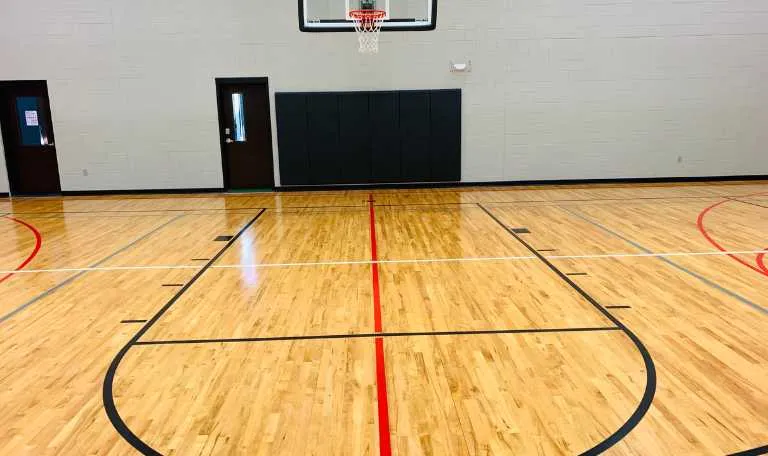How Do Quarters Shape Strategy in Basketball?
Quarters in Basketball are pivotal in shaping game strategy. Each quarter, typically lasting 12 minutes in the NBA and 10 minutes in international play, provides structured intervals that influence the pace and flow of the game. These breaks allow coaches to reassess tactics, make crucial adjustments, and manage player stamina effectively.
The division into quarters also offers opportunities for teams to reset and strategize, responding dynamically to the unfolding game. This structure ensures that the game remains engaging and competitive, with each quarter presenting a fresh chance to alter the momentum. Understanding how Quarters in Basketball impact strategy is essential for appreciating the depth and complexity.
Concept of Quarters in Basketball
In basketball, the game is divided into four periods known as quarters. Each quarter provides a structured portion of the game, where teams battle to outscore one another while adhering to time constraints.
This division allows for a more manageable and paced game, giving players and coaches time to rest, recover, and adjust their strategies as the game progresses. The division into quarters has become a fundamental part of basketball, creating a rhythm that keeps the game exciting and tactical.
Duration of Quarters in Different Leagues
The length of each quarter varies depending on the league and level of play. Here’s how different basketball organizations structure their quarters:
High School Basketball: In most high school basketball leagues, games are divided into four quarters, each lasting 8 minutes. The shorter duration accommodates the younger players’ skill levels and physical endurance, allowing for manageable gameplay without overwhelming the athletes.
NBA (National Basketball Association): NBA games consist of four quarters, each lasting 12 minutes, for a total of 48 minutes. The 12-minute quarters contribute to the high level of competition, allowing for intense gameplay while offering periodic breaks for strategic changes and player recovery.
WNBA (Women’s National Basketball Association): Each quarter lasts 10 minutes, for a total of 40 minutes of gameplay. The shorter quarter length reflects the league’s unique pace and style, promoting quick decision-making and a faster game tempo.
NCAA (National Collegiate Athletic Association): Men’s college basketball differs from professional leagues in that it is played in two 20-minute halves instead of four quarters. However, women’s college basketball follows the same four-quarter system as professional leagues, each lasting 10 minutes.
FIBA (International Basketball Federation): International basketball competitions governed by FIBA also use a four-quarter format, with each quarter lasting 10 minutes. This system is consistent across international tournaments and leagues worldwide.
Strategic Importance of Quarters
Quarters play a pivotal role in shaping the strategy employed by teams during a basketball game. The breaks between quarters provide crucial opportunities for teams to regroup, analyze the game so far, and make adjustments. These moments of rest are essential for players to recover physically and mentally, allowing them to maintain their peak performance.
Coaches take advantage of these breaks to review the game plan, analyze their opponent’s strategies, and implement changes to improve their team’s chances of success. The ability to adapt between quarters often separates winning teams from losing ones. You may know about it here at basketball stars.
End-of-Quarter Plays and Momentum Shifts
The end of each quarter holds special significance because it often marks a moment of heightened focus and pressure. Teams aim to finish quarters strong, sometimes employing specific end-of-quarter plays designed to either secure points or prevent the other team from scoring. These moments can greatly impact the momentum of the game, giving a psychological edge to the team that manages to capitalize on last-second opportunities.
For example, if a team scores a buzzer-beater at the end of a quarter, it can shift the momentum in their favor, energizing the players and boosting morale. Conversely, a strong defensive stand at the close of a quarter can have the same effect, disrupting the opposing team’s rhythm and building confidence for the next quarter.
Variations in Quarter Structure Across Leagues
While the use of quarters is consistent across many basketball leagues, the specifics of how quarters are structured can vary significantly. In the NBA, the 12-minute quarters and the 24-second shot clock create an atmosphere of urgency and excitement. Teams are pressured to make quick decisions, leading to a fast-paced, high-scoring game.
With its 10-minute quarters and identical shot clock, the WNBA emphasizes teamwork and quick ball movement. The slightly shorter quarters contribute to a quicker overall game pace, while still allowing for the development of complex plays and strategies.
In NCAA men’s basketball, the two 20-minute halves present a different challenge. Without the frequent breaks provided by quarters, teams need to manage their energy and pacing over longer stretches of time, leading to extended runs where one team dominates for an extended period. Meanwhile, women’s NCAA basketball aligns more closely with professional leagues, using the quarter format to maintain a similar pace and rhythm.
Historical Development of Quarters in Basketball
The concept of quarters in basketball has evolved over the years. In the sport’s early days, games were played in two halves, which is still the format used in men’s college basketball. However, as basketball gained popularity and more professional leagues formed, the switch to four quarters became the standard.
The adoption of quarters offered more opportunities for breaks, rest, and commercial intervals, contributing to the sport’s growth as a spectator event. Professional leagues, such as the NBA, embraced the four-quarter system to enhance the game’s structure and its entertainment value for fans.
Impact of Quarters on Player Performance
The division of the game into quarters significantly impacts player performance. Basketball is an intense sport that requires players to maintain high levels of physical and mental energy throughout the game. The breaks between quarters provide much-needed rest, allowing players to recover and avoid fatigue.
Physically, basketball’s constant movement, jumping, and physical contact take a toll on athletes. Without the structured breaks offered by quarters, players would be more prone to exhaustion and injuries. The brief pauses between quarters help prevent this by giving players time to rehydrate, rest, and mentally regroup.
Mentally, the game’s fast pace requires players to remain focused and make split-second decisions. The breaks between quarters allow players to reset mentally, discuss adjustments with coaches, and prepare for the next quarter.
The Role of Quarters in Game Strategy
Quarters are not just arbitrary divisions of time; they play a pivotal role in basketball strategy. The breaks between quarters offer opportunities for teams to regroup, analyze their opponents, and make necessary tactical adjustments. Coaches and players leverage these intervals to maintain focus and optimize performance throughout the game.
- Timeouts and Breaks: Each team is granted a set number of timeouts per game, which they can use during quarters. Timeouts allow coaches to communicate directly with their players, make substitutions, and modify game strategies based on real-time action. The strategic use of timeouts can make the difference between winning and losing in a closely contested game.
- End-of-Quarter Plays: The final moments of each quarter are often critical for shifting the game’s momentum. Teams will frequently design special plays at the end of a quarter to score points or prevent their opponents from doing so. These “end-of-quarter” plays can swing the game’s momentum in favor of one team and are often the most exciting part of the game.
Differences Across Leagues
While the basic concept of dividing games into quarters is consistent, the rules and structures governing quarters vary across different leagues. Here’s how some of the most popular basketball leagues differ in their approach:
- NBA: The NBA’s 12-minute quarters contribute to a high-scoring, fast-paced game. With a 24-second shot clock, players are required to make quick decisions, increasing the intensity of each possession. The longer quarters in the NBA offer more time for teams to execute complex offensive and defensive strategies.
- WNBA: The WNBA follows a similar format to the NBA, with 10-minute quarters and the same 24-second shot clock. The shorter quarters result in a faster overall game pace, encouraging more dynamic play. The WNBA emphasizes teamwork and efficient ball movement, creating a distinctive style of play.
- NCAA: Men’s college basketball, with its two 20-minute halves, creates a different flow than quarter-based systems. This structure allows for longer stretches of uninterrupted gameplay, leading to dramatic momentum swings and extended scoring runs. On the other hand, women’s college basketball aligns more closely with the professional leagues by using 10-minute quarters, providing a more familiar rhythm for fans and players.
- FIBA: International basketball, governed by FIBA, uses 10-minute quarters, similar to the WNBA. FIBA also has its unique set of rules, including a wider key area and slightly different regulations around timeouts and substitutions. These subtle variations make international basketball distinctive and exciting for fans of the sport.
Historical Evolution of Quarters
The use of quarters in basketball has evolved significantly since the sport’s inception. Originally, basketball games were divided into two halves, much like modern men’s college basketball. The shift to quarters was introduced to provide more structured breaks for rest and strategic planning, ultimately enhancing both the pace and the overall viewing experience.
- Early Basketball: In the early 20th century, basketball games were typically played in two halves, similar to how soccer and hockey were structured. However, as the sport grew in popularity, the need for more opportunities to adjust tactics and rest players became apparent.
- Adoption of Quarters: The professional leagues, particularly the NBA, were among the first to adopt the four-quarter format. This allowed for more commercial breaks, which increased revenue opportunities, and made the games more engaging for viewers.
- Modern Adaptations: Today, the quarter system is used in most basketball leagues, with specific variations based on league rules and player demands. The current structure balances the need for high-paced, exciting action with the practical need for player rest and strategic timeouts.
Impact on Player Performance
The division of a basketball game into quarters significantly impacts player performance. The periodic breaks help manage the physical and mental demands of the game, enabling players to perform at a high level throughout the game.
- Physical Recovery: Basketball is an extremely physical sport that involves running, jumping, and frequent contact between players. The breaks between quarters offer valuable recovery time, reducing the risk of fatigue-related injuries and helping players maintain their performance levels as the game progresses.
- Mental Focus: Besides physical recovery, the breaks between quarters offer players a chance to reset mentally. Basketball requires sharp focus and quick decision-making, so the mental respite provided during quarter breaks is essential for maintaining concentration and executing game plans effectively.
- Substitution Patterns: Coaches use the breaks between quarters to manage player rotations and substitutions. By strategically resting key players during these breaks, coaches can ensure that their best players are fresh and ready to perform during critical game moments, such as the closing minutes of the fourth quarter.
Quarters and Game Flow
The flow of a basketball game is heavily influenced by the structure of its quarters. Each quarter represents a distinct phase of the game, with its own set of challenges and opportunities. Here’s how the quarters generally unfold:
Fourth Quarter: The final quarter is typically the most intense, with teams giving their all to secure the victory. Every possession becomes critical, and strategies like time management and intentional fouling come into play as teams look to gain an edge in the final moments.
First Quarter: The first quarter sets the tone for the game. Teams typically focus on establishing their strategies and feeling out their opponents. Coaches may test different defensive schemes or offensive plays early to gauge their effectiveness.
Second Quarter: Teams often make adjustments in the second quarter based on the first quarter’s outcomes. By now, they have a better understanding of their opponents’ strengths and weaknesses and can tweak their game plans accordingly.
Third Quarter: The third quarter is pivotal for maintaining or shifting momentum. Teams with a lead at halftime often aim to extend their advantage, while those trailing may implement aggressive tactics to close the gap.
Conclusion
The division of basketball games into quarters is an essential aspect of the sport, shaping both its structure and strategy. Whether it’s the NBA’s 12-minute quarters or the WNBA and FIBA’s 10-minute versions, quarters provide a framework that balances intense competition with necessary breaks for recovery and adjustments.
Understanding the nuances of how quarters work across various leagues enhances your appreciation of basketball and highlights the game’s strategic depth. As basketball continues to evolve, the role of quarters remains central.
FAQs
1. What is a quarter in basketball?
A quarter in basketball is one of the four segments that divide the game. Each quarter lasts a set amount of time depending on the league, such as 12 minutes in the NBA or 10 minutes in the WNBA.
2. How long is each quarter in different basketball leagues?
In the NBA, each quarter is 12 minutes long. In the WNBA and FIBA, quarters last 10 minutes. High school basketball typically has 8-minute quarters, while men’s NCAA basketball uses two 20-minute halves instead of quarters.
3. Why are basketball games divided into quarters?
Quarters help to manage the game’s pace and give players and coaches opportunities to rest, adjust strategies, and refocus for the next phase of the game. This structure enhances both player performance and the viewer’s experience.
4. How do quarters impact a basketball team’s strategy?
Coaches use the breaks between quarters to analyze the opponent’s tactics, make adjustments, and rest key players. End-of-quarter plays are often crucial for gaining momentum or securing points before the next break.
5. How are quarters different in international basketball?
In international basketball, governed by FIBA, games are divided into four 10-minute quarters, similar to the WNBA. However, FIBA games include some unique rules like a wider key area and different timeout regulations compared to NBA rules.







